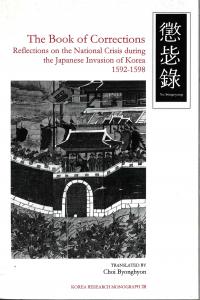The Book of Corrections
The Book of Corrections
Yu Sŏngnyong, Choi Byonghyon, trans.
The Book of Corrections (Chingbirok) is a record of the events surrounding the Japanese invasion of Korea later known as the Imjin War (1592–1598). The author, government minister Yu Sŏngnyong, vividly portrays all the major developments of the crisis, as well as the men who were involved in it. This annotated translation by Professor Choi brings to the modern reader the book's spirit of neo-Confucian self-examination, strict discipline in thought and expression, and seasoned wisdom and sincere efforts to overcome serious national crises.
As a nonprofit academic press, we need your support to publish our books. Your gift can help us make more of our titles available as e-books. DONATE NOW
Title information
The Japanese invasion of Korea in 1592, known as the Imjin War, was one of the most tragic and traumatic experiences in Korean history. The magnitude of this tragedy was unprecedented. Hundreds of thousands died, and the country was devastated. It took many years for Korea to recover. Looking back upon this tragedy from start to finish, Yu Sŏngnyong, who served as chief state councilor during most of the crisis, vividly portrays all the major developments of the crisis, as well as the men who were involved in it, persuasively demonstrating what went wrong. The purpose of writing Chingbirok (The book of corrections), as the author professes in his preface, was to prevent similar disasters from taking place in the future. His book, however, is much more revealing; it provides a lively perspective of the relationship, which has been often marked by conflicts and wars, of the three neighboring countries involved in the war—Korea, Japan, and China.
Yu Sŏngnyong
Yu Sŏngnyong (1547–1607) was a neo-Confucian scholar of Korean.
Choi Byonghyon, trans.
Choi Byonghyon is professor of American literature at Honam University, Korea.
The Book of Corrections (KRM 28 )
Abbreviations Used in the Notes - viii
Translator's Preface - ix
Illustrations - xiii
Introduction - 1
Author's Preface - 15
BOOK I - 17
1. The Envoys from Japan – 19
2. Japanese Envoy Sō Yoshitoshi – 24
3. Korean Envoys Meet with Toyotomi Hideyoshi – 28
4. Korea Informs Ming of the Japanese Plot – 32
5. Controversies over Rebuilding the National Defense – 34
6. Yi Sunsin Appointed as the Navy Commander – 37
7. Generals Unable to Foresee the Imminent War – 42
8. Invasion of the Japanese – 44
9. Our Fortresses Fall One after Another – 46
10. Urgent Reports Come In – 50
11. Criminal Charges against Kim Sŏng'il for His Report – 55
12. The Court Appoints Kim Nŭk to Stabilize Public Feeling – 57
13. Commander Yi Il Flees as Sangju Falls – 58
14. Debates on the Defense of Seoul and the Departure of the King – 62
15. The Defeat of Sin Ip's Army – 67
16. The Day of Moaning and Wailing – 71
17. Seoul Falls into Enemy Hands – 78
18. The Collapse of Our Joint Forces at Yong'in – 81
19. Sin Kak's Victory and His Tragic End – 83
20. The Collapse of the Defense Line at the Imjin River – 85
21. The Japanese Enter Hamgyŏng Province and Capture Our Two Princes – 87
22. Yi Il Arrives at P'yŏngyang after Losing His Battle – 90
23. The Visit of Lin Shilu to P'yŏngyang – 93
24. The Royal Carriage Leaves P'yŏngyang – 100
25. The Fall of P'yŏngyang – 106
26. Anger and Frustration of the People – 109
27. The King Arrives at Ŭiju and Ming Sends Its Relief Army – 114
28. The Vanguard of the Ming Relief Army Arrives – 116
29. Ming Relief Army Fails to Recapture P'yŏngyang – 119
30. Yi Sunsin Defeats the Japanese Navy with His Turtle Ships – 121
31. Cho Hoik, a Man of Loyalty and Patriotism – 125
32. The Defense of Chŏnju and the Brave Battles of Chŏng Tam – 127
33. An Attempt to Recapture P'yŏngyang – 129
34. Shen Weijing Visits the Japanese Camp – 131
35. The Tragic Death of Governor Sim Tae – 134
36. General Wŏn Ho Defeats the Japanese – 137
37. Kwŏn Ŭngsu and Others Recapture Yŏngch'ŏn – 139
38. Pak Chin Recaptures Kyŏngju – 141
39. The Rise of the Righteous Volunteer Armies – 143
40. Yi Il Becomes a Commander – 149
41. Spies and Traitors – 151
BOOK II – 153
42. New Ming Relief Army Recaptures P'yŏngyang – 155
43. The Court Replaces Yi Il with Yi Pin – 161
44. The Ming Army Retreats to Kaesŏng after Losing the Battle of Pyŏkche – 162
45. Victory at Haengju Fortress – 169
46. Efforts to Save the Starving People – 173
47. Shen Weijing's Efforts to Make Peace with the Japanese – 176
48. Recapturing Seoul – 181
49. Devastating Defeat at the Battle of Chinju – 184
50. The King Returns to Seoul – 189
51. The Imprisonment of Yi Sunsin – 197
52. The Breakdown of the Peace Talks and a New Relief Army from Ming China – 200
53. The Collapse of the Navy Led by Wŏn Kyun – 201
54. The Battle of Hwangsŏk Mountain Fortress – 205
|
JOURNAL REVIEWS |
|
"This is a translation by a poet, and it is a good one….[W]e finally have a good English translation of a text that has been cherished by Koreans and Japanese for half a millennium. Let us hope that it entices fledgling scholars into the open field that is the history of interactions among Chinese, Koreans, and Japanese." ~James B. Lewis, University of Oxford, in The Journal of Asian Studies (http://www.jstor.org/stable/4133426) |


